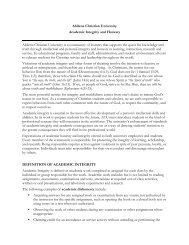The Influence of the Emperor Cult on the - Abilene Christian University
The Influence of the Emperor Cult on the - Abilene Christian University
The Influence of the Emperor Cult on the - Abilene Christian University
Create successful ePaper yourself
Turn your PDF publications into a flip-book with our unique Google optimized e-Paper software.
56 RESTORATION QUARTERLY<br />
Before exploring how <str<strong>on</strong>g>the</str<strong>on</strong>g> text <str<strong>on</strong>g>of</str<strong>on</strong>g> Revelati<strong>on</strong> can be illuminated by socialhistorical<br />
research, we will first examine <str<strong>on</strong>g>the</str<strong>on</strong>g> data for <str<strong>on</strong>g>the</str<strong>on</strong>g> emperor cult in <str<strong>on</strong>g>the</str<strong>on</strong>g><br />
cities <str<strong>on</strong>g>of</str<strong>on</strong>g> <str<strong>on</strong>g>the</str<strong>on</strong>g> Apocalypse and <str<strong>on</strong>g>the</str<strong>on</strong>g>n detail what can be said about <str<strong>on</strong>g>the</str<strong>on</strong>g> actual practices<br />
in <str<strong>on</strong>g>the</str<strong>on</strong>g> emperor cult. According to S. R. F. Price, evidence exists for <str<strong>on</strong>g>the</str<strong>on</strong>g><br />
emperor cult during or before <str<strong>on</strong>g>the</str<strong>on</strong>g> reign <str<strong>on</strong>g>of</str<strong>on</strong>g> Domitian in four <str<strong>on</strong>g>of</str<strong>on</strong>g> <str<strong>on</strong>g>the</str<strong>on</strong>g> seven cites<br />
menti<strong>on</strong>ed in Revelati<strong>on</strong> 2–3 (viz., Ephesus, Smyrna, Pergamum, and<br />
3 Laodicea). This secti<strong>on</strong> presents and evaluates <str<strong>on</strong>g>the</str<strong>on</strong>g> evidence for this claim.<br />
Ephesus<br />
In many respects, <str<strong>on</strong>g>the</str<strong>on</strong>g> evidence regarding Ephesus provides <str<strong>on</strong>g>the</str<strong>on</strong>g> best point<br />
<str<strong>on</strong>g>of</str<strong>on</strong>g> departure. <str<strong>on</strong>g>The</str<strong>on</strong>g> sources are varied, from archeological and epigraphic<br />
evidence to literary texts. In additi<strong>on</strong>, up to five temples are represented.<br />
<str<strong>on</strong>g>The</str<strong>on</strong>g> temple <str<strong>on</strong>g>of</str<strong>on</strong>g> Roma and Julius Caesar is <strong>on</strong>e <str<strong>on</strong>g>of</str<strong>on</strong>g> <str<strong>on</strong>g>the</str<strong>on</strong>g> few temples attested by<br />
literary evidence. Dio Cassius (fl. ca. A.D. 200) describes <str<strong>on</strong>g>the</str<strong>on</strong>g> h<strong>on</strong>ors Octavian<br />
granted Julius Caesar and Roma in 29 B.C.:<br />
Caesar (i.e., Octavian), meanwhile, besides attending to <str<strong>on</strong>g>the</str<strong>on</strong>g> general business, gave<br />
permissi<strong>on</strong> for <str<strong>on</strong>g>the</str<strong>on</strong>g> dedicati<strong>on</strong> <str<strong>on</strong>g>of</str<strong>on</strong>g> sacred precincts () in Ephesus and in<br />
Nicaea to Rome [i.e., Roma] and to Caesar, his fa<str<strong>on</strong>g>the</str<strong>on</strong>g>r, whom he named <str<strong>on</strong>g>the</str<strong>on</strong>g> hero<br />
Julius. <str<strong>on</strong>g>The</str<strong>on</strong>g>se cities had at that time attained chief place in Asia and in Bithynia<br />
respectively. He commanded that <str<strong>on</strong>g>the</str<strong>on</strong>g> Romans resident in <str<strong>on</strong>g>the</str<strong>on</strong>g>se cities should pay<br />
h<strong>on</strong>our to <str<strong>on</strong>g>the</str<strong>on</strong>g>se two divinities (’ . . . ); but he permitted <str<strong>on</strong>g>the</str<strong>on</strong>g><br />
aliens, whom he styled Hellenes, to c<strong>on</strong>secrate precincts () to himself,<br />
<str<strong>on</strong>g>the</str<strong>on</strong>g> Asians to have <str<strong>on</strong>g>the</str<strong>on</strong>g>irs in Pergamum and <str<strong>on</strong>g>the</str<strong>on</strong>g> Bithynians <str<strong>on</strong>g>the</str<strong>on</strong>g>irs in Nicomedia. This<br />
practice, beginning under him, has been c<strong>on</strong>tinued under o<str<strong>on</strong>g>the</str<strong>on</strong>g>r emperors, not <strong>on</strong>ly<br />
in <str<strong>on</strong>g>the</str<strong>on</strong>g> case <str<strong>on</strong>g>of</str<strong>on</strong>g> <str<strong>on</strong>g>the</str<strong>on</strong>g> Hellenic nati<strong>on</strong>s but also in that <str<strong>on</strong>g>of</str<strong>on</strong>g> all <str<strong>on</strong>g>the</str<strong>on</strong>g> o<str<strong>on</strong>g>the</str<strong>on</strong>g>rs, in so far as <str<strong>on</strong>g>the</str<strong>on</strong>g>y<br />
are subject to <str<strong>on</strong>g>the</str<strong>on</strong>g> Romans. For in <str<strong>on</strong>g>the</str<strong>on</strong>g> capital itself and in Italy generally no<br />
emperor, however worthy <str<strong>on</strong>g>of</str<strong>on</strong>g> renown he has been, has dared to do this; still, even<br />
<str<strong>on</strong>g>the</str<strong>on</strong>g>re various divine h<strong>on</strong>ours are bestowed ( )<br />
after <str<strong>on</strong>g>the</str<strong>on</strong>g>ir death up<strong>on</strong> such emperors as have ruled uprightly, and, in fact, shrines<br />
are built to <str<strong>on</strong>g>the</str<strong>on</strong>g>m ( ). 4<br />
A number <str<strong>on</strong>g>of</str<strong>on</strong>g> salient details require discussi<strong>on</strong>. First, <strong>on</strong>e notices <str<strong>on</strong>g>the</str<strong>on</strong>g><br />
menti<strong>on</strong> <str<strong>on</strong>g>of</str<strong>on</strong>g> “sacred precincts” to Roma and Julius Caesar in Ephesus. <str<strong>on</strong>g>The</str<strong>on</strong>g><br />
presence <str<strong>on</strong>g>of</str<strong>on</strong>g> <str<strong>on</strong>g>the</str<strong>on</strong>g>se “sacred precincts” is supported by archeological data: “This<br />
podium, formerly known as <str<strong>on</strong>g>the</str<strong>on</strong>g> state altar, has now been identified as a podium<br />
with two small prostyle temples built by Augustus in 29 B.C. for <str<strong>on</strong>g>the</str<strong>on</strong>g> Divus Iulius<br />
and Dea Roma; it was destroyed in <str<strong>on</strong>g>the</str<strong>on</strong>g> fourth century A.D.” 5<br />
3 S. R. F. Price, Rituals and Power: <str<strong>on</strong>g>The</str<strong>on</strong>g> Roman Imperial <str<strong>on</strong>g>Cult</str<strong>on</strong>g> in Asia Minor<br />
(Cambridge: Cambridge <strong>University</strong> Press, 1984), 252–64.<br />
4 Dio Cassius, Roman History, 51.20.6–8 (E. Cary, LCL 6.56–59).<br />
5 V. Mitsopoulou-Le<strong>on</strong>, “Ephesos,” Princet<strong>on</strong> Encyclopedia <str<strong>on</strong>g>of</str<strong>on</strong>g> Classical Sites, 307.<br />
For <str<strong>on</strong>g>the</str<strong>on</strong>g> locati<strong>on</strong> <str<strong>on</strong>g>of</str<strong>on</strong>g> <str<strong>on</strong>g>the</str<strong>on</strong>g> temple area, see #9 <strong>on</strong> <str<strong>on</strong>g>the</str<strong>on</strong>g> map between 760 and 761 (for discussi<strong>on</strong>,<br />
see 815–16) in “Ephesos vom Beginn der römischen Herrschaft in Kleinasien bis<br />
zum Ende der Principatszeit” (Dieter Knibbe and Wilhelm Alzinger, ANRW 2.7.2).
















